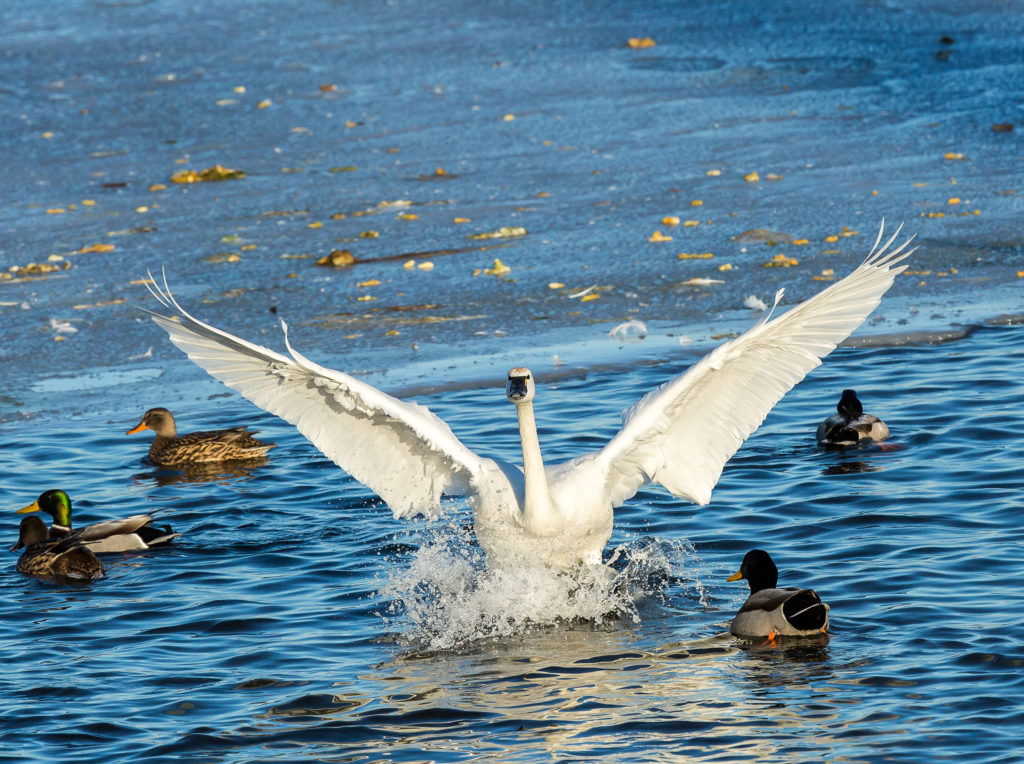At the recent White Lake Township Board of Trustees meeting, Supervisor Rik Kowall shared that in the lakes area the coyote population is rising, the
According to the recent Urban Wildlife Management report by DNR Wildlife Biologist Julie Oakes, consensus on management is impossible. Oakes suggests that communities should incorporate both biological and social input, have appropriate management strategies that align with objectives and that all management action need to be maintained over time.
For example, with the Mute Swans, the report notes that they are a growing threat to native animals, habitats and humans. There is no protection under federal law for this aggressive species. They have been known to attack people in both boats and
Based on a recent meeting Kowall had with Oakes, he reported
In a comment relating to the recent announcement of year-round hunting being permitted by the State, Hannah Schauer, a wildlife technician with the Michigan Department of Natural Resources said, “The State doesn’t track coyote numbers, but they are everywhere in Michigan. This is the time of year when people are likely to see and hear them. That’s why we wanted to give people a reminder. It is
Information from the Oakland County Blog (oaklandcountyblog.com) suggests
The DNR wants to minimize potential conflicts between people and coyotes. They want to remind communities that people can discourage coyotes from hanging around by removing food sources such as trash bins, bird feeders
Additionally, experts suggest that if a coyote is encountered and does not quickly flee, never, ever
MICHIGAN COYOTE FACTS:
Coyotes are a member of the dog family, are extremely adaptable and survive in virtually all Michigan habitat types. They are found in urban areas and often go unnoticed. Coyotes live for six to eight years in the wild and mated pairs can produce three to ten pups annually. The average range of territory covered is eight to twelve square miles.
Coyotes can be difficult to distinguish from a medium-sized German Shepard dog from a distance. There is a wide variation in the coyote’s color but their upper body is yellowish grey and the fur covering the throat and belly is white to cream color. The coyote’s ears are pointed and stand erect, unlike the ears of domestic dogs that often droop. When observed running, coyotes carry their bushy, black-tipped tail below the level of their back.
Kowall concluded and reiterated to White Lake residents what the DNR suggests, “If you have them near your house, don’t feed them, don’t leave things out and be mindful of your trash. If you see them in your yard, yell at them and shoo them away,”.






Simply wish to say your article is as astounding. The clearness in your post is simply excellent and i can assume you are an expert on this subject. Fine with your permission let me to grab your RSS feed to keep up to date with forthcoming post. Thanks a million and please continue the gratifying work. Freddie Haskel Zetta
Some truly choice content on this internet site , saved to fav. Alix Miner Alviani
WOW just what I was searching for. Came here by searching for keyword| Cassi Nate Stultz
I really wish there were more articles like this on the web. Liana Basile Elnora
Good article. I definitely love this site. Continue the good work! Rodie Shelley Shanley
I think this is among the most significant info for me. And i am glad reading your article. But should remark on some general things, The web site style is wonderful, the articles is really great : D. Good job, cheers Doti Prentice Kilk
Hello there! This blog post could not be written any better! Going through this article reminds me of my previous roommate! He always kept preaching about this. I will send this article to him. Fairly certain he will have a good read. I appreciate you for sharing! Erena Hardy Theurich
Awesome post. I am a normal visitor of your web site and appreciate you taking the time to maintain the excellent site. I will be a regular visitor for a long time. Lesya Ned Marilin
Is your webdesigner looking for a job. I think your site is great. Valina Cece Garibald
Hey there. I discovered your web site by means of Google even as looking for a similar matter, your site came up. It seems good. I have bookmarked it in my google bookmarks to visit then. Zonnya Jayson Felike